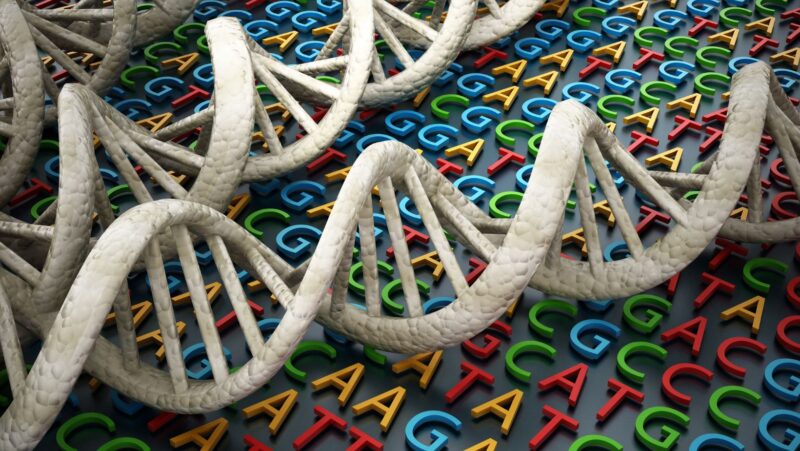Ex-toc
 Delving into the intricate world of DNA, we often stumble upon terms that seem confusing, yet they hold the key to our genetic blueprint. Two such terms are the ‘template strand’ and the ‘coding strand’. They’re not just fancy jargon thrown around in the genetics world, but crucial elements of DNA transcription.In the dance of life, these strands play pivotal roles. They’re the unsung heroes, silently working in the background, dictating the creation of proteins, the building blocks of our body. But what makes them different? How do they interact within our cells? Let’s unravel the mystery of the template strand and the coding strand, and explore the fascinating roles they play in our genetic makeup.
Delving into the intricate world of DNA, we often stumble upon terms that seem confusing, yet they hold the key to our genetic blueprint. Two such terms are the ‘template strand’ and the ‘coding strand’. They’re not just fancy jargon thrown around in the genetics world, but crucial elements of DNA transcription.In the dance of life, these strands play pivotal roles. They’re the unsung heroes, silently working in the background, dictating the creation of proteins, the building blocks of our body. But what makes them different? How do they interact within our cells? Let’s unravel the mystery of the template strand and the coding strand, and explore the fascinating roles they play in our genetic makeup.
Template Strand Vs Coding Strand
 In the realm of DNA transcription, two significant strands emerge – the template strand and the coding strand.The template strand, often identified as the anti-coding strand, bears a crucial role in the transcription process. It directs the assemblage of RNA molecules, functioning as a stencil, or ‘template’ for the construction of a unique mRNA chain. This strand exhibits a 3′ to 5′ orientation, denoting its direction in the DNA double-helix structure.On the other hand, the coding strand, also known as the sense strand, differs from the template strand in its function, yet is paramount in the process. It possesses a 5′ to 3′ orientation, mirroring that of the resulting mRNA. Understanding the working mechanism of both strands uplifts our knowledge about our genetic code and offers meaningful insights into the intricate operations of life. Noteworthy is that modern advancements in technology leverage this understanding, facilitating breakthroughs in areas like gene therapy and genetic engineering.Thus, the template strand vs coding strand exploration casts lights on the intricate DNA structure, highlighting the DNA’s brilliant orchestration in protein synthesis.
In the realm of DNA transcription, two significant strands emerge – the template strand and the coding strand.The template strand, often identified as the anti-coding strand, bears a crucial role in the transcription process. It directs the assemblage of RNA molecules, functioning as a stencil, or ‘template’ for the construction of a unique mRNA chain. This strand exhibits a 3′ to 5′ orientation, denoting its direction in the DNA double-helix structure.On the other hand, the coding strand, also known as the sense strand, differs from the template strand in its function, yet is paramount in the process. It possesses a 5′ to 3′ orientation, mirroring that of the resulting mRNA. Understanding the working mechanism of both strands uplifts our knowledge about our genetic code and offers meaningful insights into the intricate operations of life. Noteworthy is that modern advancements in technology leverage this understanding, facilitating breakthroughs in areas like gene therapy and genetic engineering.Thus, the template strand vs coding strand exploration casts lights on the intricate DNA structure, highlighting the DNA’s brilliant orchestration in protein synthesis.
Overview of DNA Transcription Process
Let’s delve deeper into the specifics of DNA transcription, emphasizing on the roles of both the template and coding strands.
Role of Template Strand in Transcription
 In DNA transcription, the template strand, also known as the antisense strand, takes on an indispensable role. It directs the assembly of messenger RNA (mRNA). Transcription begins when the RNA polymerase enzyme binds to the promoter region of the DNA. From there, the enzyme unwinds the DNA helix, revealing the template strand.RNA polymerase reads the nucleotide sequence of the template strand from 3′ to 5′ direction. This reading sets off the formation of an RNA transcript; a process termed as transcription. For each nucleotide read on the template strand, a complementary RNA nucleotide is integrated into the growing mRNA chain. That’s how the template strand serves as a blueprint for building the mRNA sequence.
In DNA transcription, the template strand, also known as the antisense strand, takes on an indispensable role. It directs the assembly of messenger RNA (mRNA). Transcription begins when the RNA polymerase enzyme binds to the promoter region of the DNA. From there, the enzyme unwinds the DNA helix, revealing the template strand.RNA polymerase reads the nucleotide sequence of the template strand from 3′ to 5′ direction. This reading sets off the formation of an RNA transcript; a process termed as transcription. For each nucleotide read on the template strand, a complementary RNA nucleotide is integrated into the growing mRNA chain. That’s how the template strand serves as a blueprint for building the mRNA sequence.
Role of Coding Strand in Transcription
 The coding strand, on the other hand, is the eponym of DNA transcription. Also referred to as the sense or non-template strand, the coding strand runs parallel to the mRNA transcript synthesized during transcription. It bears the same nucleotide sequences as the mRNA, albeit with thymine (T) in DNA replaced by uracil (U) in mRNA.Although RNA polymerase doesn’t read the coding strand during transcription, it’s called the coding or sense strand because it carries the same genetic code expressed in the mRNA. It’s essentially a mirror image of the template strand, minus the substitution of uracil (U) for thymine (T). In essence, while the template strand is actively read and transcribed in the production of mRNA, the coding strand plays a silent yet significant role in carrying the genetic data.
The coding strand, on the other hand, is the eponym of DNA transcription. Also referred to as the sense or non-template strand, the coding strand runs parallel to the mRNA transcript synthesized during transcription. It bears the same nucleotide sequences as the mRNA, albeit with thymine (T) in DNA replaced by uracil (U) in mRNA.Although RNA polymerase doesn’t read the coding strand during transcription, it’s called the coding or sense strand because it carries the same genetic code expressed in the mRNA. It’s essentially a mirror image of the template strand, minus the substitution of uracil (U) for thymine (T). In essence, while the template strand is actively read and transcribed in the production of mRNA, the coding strand plays a silent yet significant role in carrying the genetic data.
What is a Template Strand?
Definition and Function of Template Strand
 A template strand, in the realm of genetics, functions as a director for RNA synthesis. This part of the DNA duplex acts as a pattern to which ribonucleotides adhere during the transcription process. By doing so, it effectively molds a sequence of messenger RNA (mRNA) that’s complementary to itself. In essence, it’s the genetic guidebook the cell uses when preparing to generate protein molecules.
A template strand, in the realm of genetics, functions as a director for RNA synthesis. This part of the DNA duplex acts as a pattern to which ribonucleotides adhere during the transcription process. By doing so, it effectively molds a sequence of messenger RNA (mRNA) that’s complementary to itself. In essence, it’s the genetic guidebook the cell uses when preparing to generate protein molecules.
Importance of Template Strand in Protein Synthesis
 The template strand’s role in protein generation proves pivotal, not to be understated. By functioning as a blueprint utilized by RNA polymerase during the transcription process, it facilitates the creation of a precise mRNA sequence. This mRNA travels to the ribosomes, the protein factories of the cell, where it then undergoes translation into a specific amino acid sequence. Thus, the template strand directly dictates the identity of proteins synthesized by cells, rendering it a highly critical component in the bounds of molecular biology.
The template strand’s role in protein generation proves pivotal, not to be understated. By functioning as a blueprint utilized by RNA polymerase during the transcription process, it facilitates the creation of a precise mRNA sequence. This mRNA travels to the ribosomes, the protein factories of the cell, where it then undergoes translation into a specific amino acid sequence. Thus, the template strand directly dictates the identity of proteins synthesized by cells, rendering it a highly critical component in the bounds of molecular biology.
Understanding the Coding Strand
 In the fascinating realm of DNA transcription, our next stop brings us to understand the coding strand. A close associate to the template strand, it boasts a distinct role and functionality, dovetailing with molecular biology’s meticulous orchestrations.
In the fascinating realm of DNA transcription, our next stop brings us to understand the coding strand. A close associate to the template strand, it boasts a distinct role and functionality, dovetailing with molecular biology’s meticulous orchestrations.
Definition and Role of Coding Strand
 The DNA molecule, in its intricate design, boasts two strands – the template and the coding strands. The coding strand, not directly involved in transcription, carries the same sequence of the mRNA (apart from T replaced by U in RNA). Coding strand, precisely due to its matching sequence with mRNA, often goes by the name “sense strand.” It might seem like it’s on the sidelines, but in reality, it’s a hero behind the scenes. Although it doesn’t guide the RNA assembly like its counterpart, the coding strand serves as the meticulous transcription mirror, accurately serving as the transcription model.
The DNA molecule, in its intricate design, boasts two strands – the template and the coding strands. The coding strand, not directly involved in transcription, carries the same sequence of the mRNA (apart from T replaced by U in RNA). Coding strand, precisely due to its matching sequence with mRNA, often goes by the name “sense strand.” It might seem like it’s on the sidelines, but in reality, it’s a hero behind the scenes. Although it doesn’t guide the RNA assembly like its counterpart, the coding strand serves as the meticulous transcription mirror, accurately serving as the transcription model.
The Relationship between Coding Strand and mRNA
 Let’s delve a bit deeper into the relationship between the coding strand and mRNA. In the intricate process of transcription, RNA polymerase reads the genetic code on the template strand and synthesizes mRNA. This mRNA sequence matches the sequence of the coding strand, the only difference being the substitution of Thymine (T) in the DNA strand with Uracil (U) in the RNA strand.This matching sequence is a fundamental reason why the coding strand also goes by the name ‘sense’ strand. The mRNA matched sequence, in turn, forms the genetic instructions for protein synthesis, essentially affecting every functional aspect of a living cell.The coding strand mirrors into mRNA, which aids in protein synthesis — a clever trick nature employs, turning biological processes into feats of technological genius. From this perspective, the understanding of the template strand vs coding strand acquires a new depth, demonstrating the intricate mechanics of molecular biology and its undeniable impact on life as we know it.
Let’s delve a bit deeper into the relationship between the coding strand and mRNA. In the intricate process of transcription, RNA polymerase reads the genetic code on the template strand and synthesizes mRNA. This mRNA sequence matches the sequence of the coding strand, the only difference being the substitution of Thymine (T) in the DNA strand with Uracil (U) in the RNA strand.This matching sequence is a fundamental reason why the coding strand also goes by the name ‘sense’ strand. The mRNA matched sequence, in turn, forms the genetic instructions for protein synthesis, essentially affecting every functional aspect of a living cell.The coding strand mirrors into mRNA, which aids in protein synthesis — a clever trick nature employs, turning biological processes into feats of technological genius. From this perspective, the understanding of the template strand vs coding strand acquires a new depth, demonstrating the intricate mechanics of molecular biology and its undeniable impact on life as we know it.

